Beelink GTR7 mini-PC Review: A Complete AMD Phoenix Package at 65W
by Ganesh T S on August 24, 2023 8:00 AM ESTGPU Performance: Synthetic Benchmarks
AMD's Phoenix SoCs include an integrated GPU with a microarchitectural update over the one in the Rembrandt-R SoCs. The new RDNA3 microarchitecture is present in the Ryzen 7 7840HS in the form of the Radeon 780M. With 12 CUs and 768 shader units clocked at 2.7 GHz, AMD claims that the GPU should be capable of playing virtually any modern game at Full HD resolutions.
For full-blown desktop systems or mini-PCs targeting the gaming market, we look at gaming workloads. However, for general-purpose mini-PC models like the GEEKOM AS 6, we restrict ourselves to a series of canned benchmarks from Kishonti and Futuremark / UL. Prior to that, a look at the capabilities of the GPU via GPU-Z is warranted.
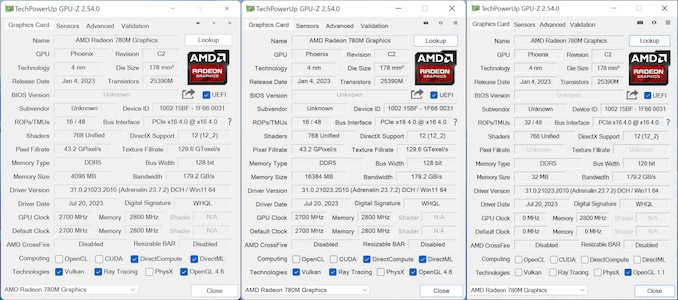
(From L to R: Default BIOS Settings, UMA Buffer Size set to 16G, UMA Buffer Size set to Auto)
Rembrandt-R's Radeon 680M had already achieved an industry-first by integrating hardware-accelerated ray tracing, and the Radeon 780M in Phoenix builds upon that. There are some improvements in the media engine too (such as AV1 encode support), but those are not revealed in the GPU-Z screenshot. The remaining subsections below look into the performance aspects.
GFXBench
The DirectX 12-based GFXBench tests from Kishonti are cross-platform, and available all the way down to smartphones. As such, they are not very taxing for discrete GPUs and modern integrated GPUs. We processed the offscreen versions of the 'Aztec Ruins' benchmark.
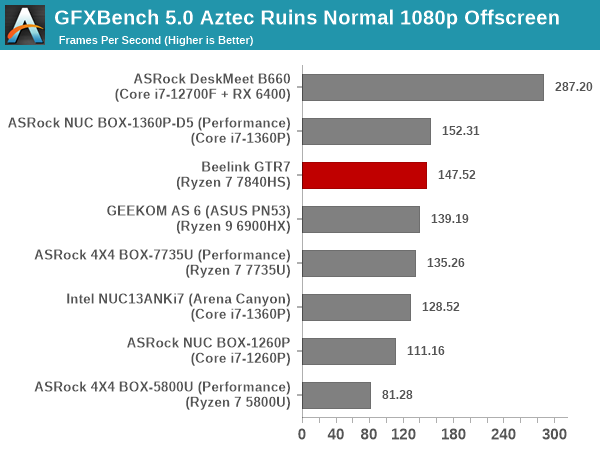
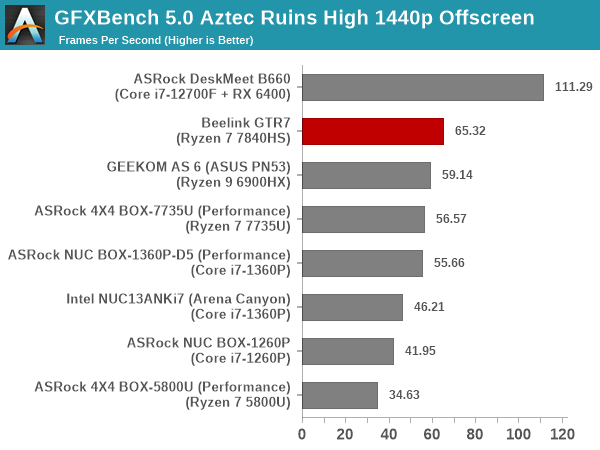
At 1080p, the souped-up ASRock Industrial Raptor Lake-P NUC has a slight edge of around 3% in the frame rate, but the AMD-based systems take back the crown at 1440p. The GTR7 has a 7% edge over the GEEKOM AS 6, which by itself has a 6% edge over the top RPL-P system.
UL 3DMark
Four different workload sets were processed in 3DMark - Fire Strike, Time Spy, Night Raid, and Wild Life.
3DMark Fire Strike
The Fire Strike benchmark has three workloads. The base version is meant for high-performance gaming PCs. It uses DirectX 11 (feature level 11) to render frames at 1920 x 1080. The Extreme version targets 1440p gaming requirements, while the Ultra version targets 4K gaming system, and renders at 3840 x 2160. The graph below presents the overall score for the Fire Strike Extreme and Fire Strike Ultra benchmark across all the systems that are being compared.
| UL 3DMark - Fire Strike Workloads | |||
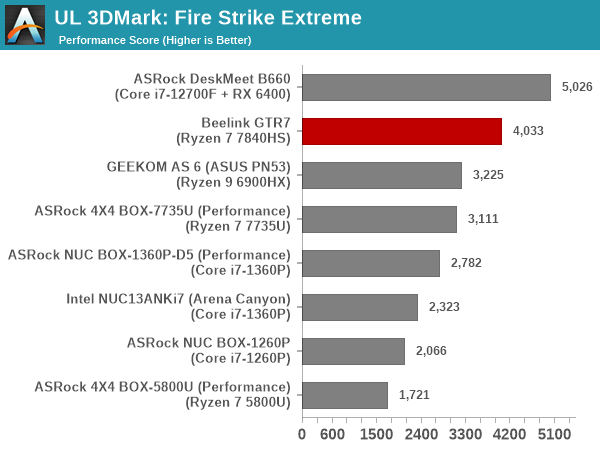
Rembrandt-R already had an edge over RPL-P in these workloads, and Phoenix only cements this position further. The GTR7 shows a 25 - 30% improvement over the GEEKOM AS 6 behind it - a result of the microarchitectural improvements as well as higher power budget.
3DMark Time Spy
The Time Spy workload has two levels with different complexities. Both use DirectX 12 (feature level 11). However, the plain version targets high-performance gaming PCs with a 2560 x 1440 render resolution, while the Extreme version renders at 3840 x 2160 resolution. The graphs below present both numbers for all the systems that are being compared in this review.
| UL 3DMark - Time Spy Workloads | |||
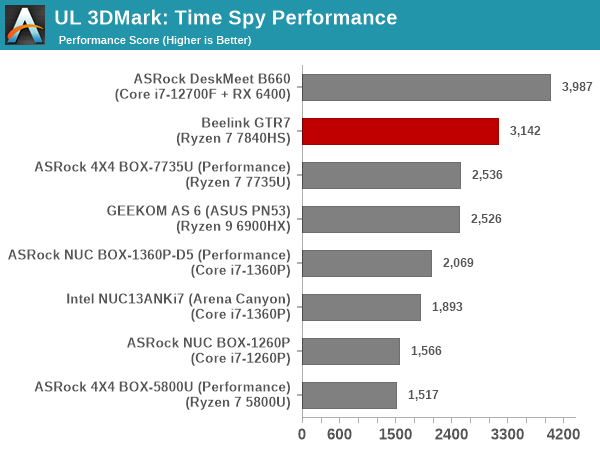
The observations made in Fire Strike workloads hold true for Time Spy also. The advantage for GTR7 over the 42W Ryzen 7 7735U in the ASRock Industrial 4X4 BOX-7735U is around 25%.
3DMark Wild Life
The Wild Life workload was initially introduced as a cross-platform GPU benchmark in 2020. It renders at a 2560 x 1440 resolution using Vulkan 1.1 APIs on Windows. It is a relatively short-running test, reflective of mobile GPU usage. In mid-2021, UL released the Wild Life Extreme workload that was a more demanding version that renders at 3840 x 2160 and runs for a much longer duration reflective of typical desktop gaming usage.
| UL 3DMark - Wild Life Workloads | |||
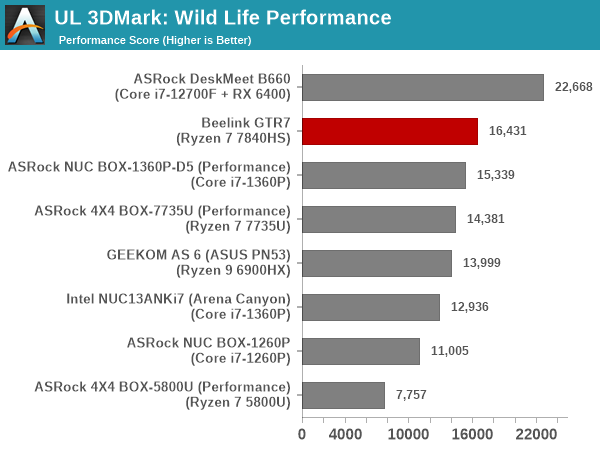
3D Mark Wild Life was one of the GPU workloads where RPL-P's iGPU had performed better than the Radeon 680M in the Rembrandt-R systems. The GTR7's Radeon 780M wrests the crown from the ASRock Industrial NUC BOX-1360P/D5, showing a 7% increase in performance at 1440p and 17% increase at 2160p. This is doubtless due to the improved microarchitecture and higher power budget.
3DMark Night Raid
The Night Raid workload is a DirectX 12 benchmark test. It is less demanding than Time Spy, and is optimized for integrated graphics. The graph below presents the overall score in this workload for different system configurations.
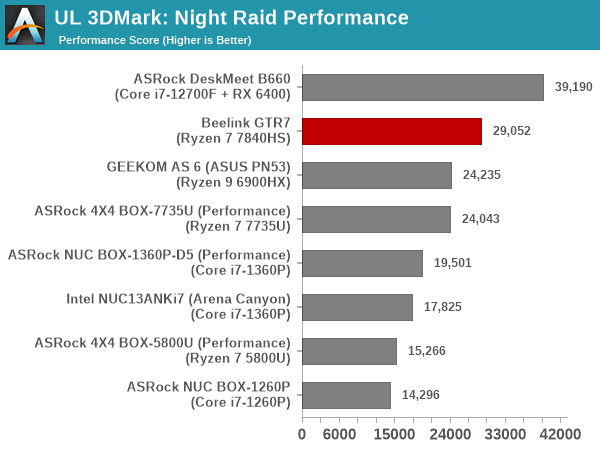
The GTR7 is comfortable on top when systems with iGPUs are considered, with a 20% advantage over the GEEKOM AS 6 (which has a 20% advantage over the best that RPL-P has to offer).
3DMark Port Royal
UL introduced the Port Royal ray-tracing benchmark as a DLC for 3DMark in early 2019. The scores serve as an indicator of how the system handles ray-tracing effects in real-time.
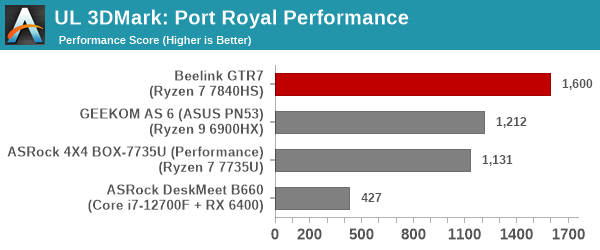
The GTR7 has a 30%+ advantage over the GEEKOM AS 6, thanks to improvements in the ray tracing engine, as well as faster iGPU clocks.


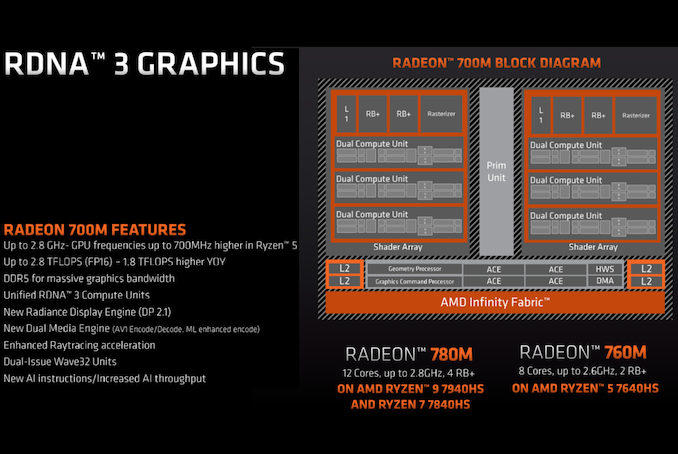








56 Comments
View All Comments
darkswordsman17 - Friday, August 25, 2023 - link
Apple doesn't need to pay anyone, nor would they have someone posting in such a manner even if they did, let alone on a niche PC tech website that's long past its glory days.1_rick - Thursday, August 24, 2023 - link
"It's superior to this in just about every way."Not if I don't want to run MacOS.
StormyParis - Thursday, August 24, 2023 - link
The 7840hs seems to be- on par for single-core work
- 1.5 to 2x faster for multi-core
- 1.5x faster for graphics
- also it takes more and/or upgradeable RAM, storage, I/O, OSes...
https://nanoreview.net/en/cpu-compare/apple-m2-vs-...
Gm2502 - Sunday, August 27, 2023 - link
Are youj high, where in the world is a M2 faster then this 😂😂😂😂. All the benchmarks show this destroying M2 in every way, it can be upgraded, repaired and run windows. Another apple fanboy 😂😂😂bsd228 - Monday, August 28, 2023 - link
That 499 price is true for the basic model no one in their right mind wants, but the discount drops once you try to add on the other wants. The 16gb model is discounted 50, but that still makes it a $250 upgrade. If you want more disk, you're back to the 599 msrp plus the Apple charge. If you want 10gb over the weak 1gb, you're definitely paying msrp.The 5800u is a not quite at the 7840, but $350 for it with 32gb, 2x2.5gb and 500gb (replaceable) ssd is a much better docker box than the apple could ever hope to be.
BangkokTom - Tuesday, August 29, 2023 - link
...takes M2 mini apart, oh purposely bricked (this is a joke with Crapple's fix it yourself policy by the way)sjkpublic@gmail.com - Friday, September 1, 2023 - link
Ignore this person. Just a shil for the Apple monopoly.Threska - Thursday, August 24, 2023 - link
Kind of funny in a way. We've gone from obsessing with big computers to seeing how much computing we can squeeze into as small a space as possible.5080 - Thursday, August 24, 2023 - link
Would be nice to see a build quality review and comparison between this and the SimplyNUC (Moonstone), Morefine (M600), and MinisForum (UM790 Pro) NUC's.NextGen_Gamer - Thursday, August 24, 2023 - link
Yes! Also, I really want these guys to release them barebones, so I can put in my own RAM/SSD (without wasting money on the included ones). I got in touch with Morefine, and they told me they are no longer releasing the M600 barebones and only as a full kit now (if you check their website, you see this is true).